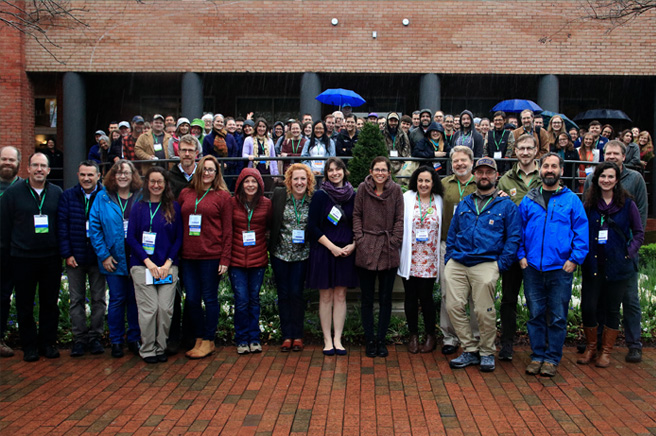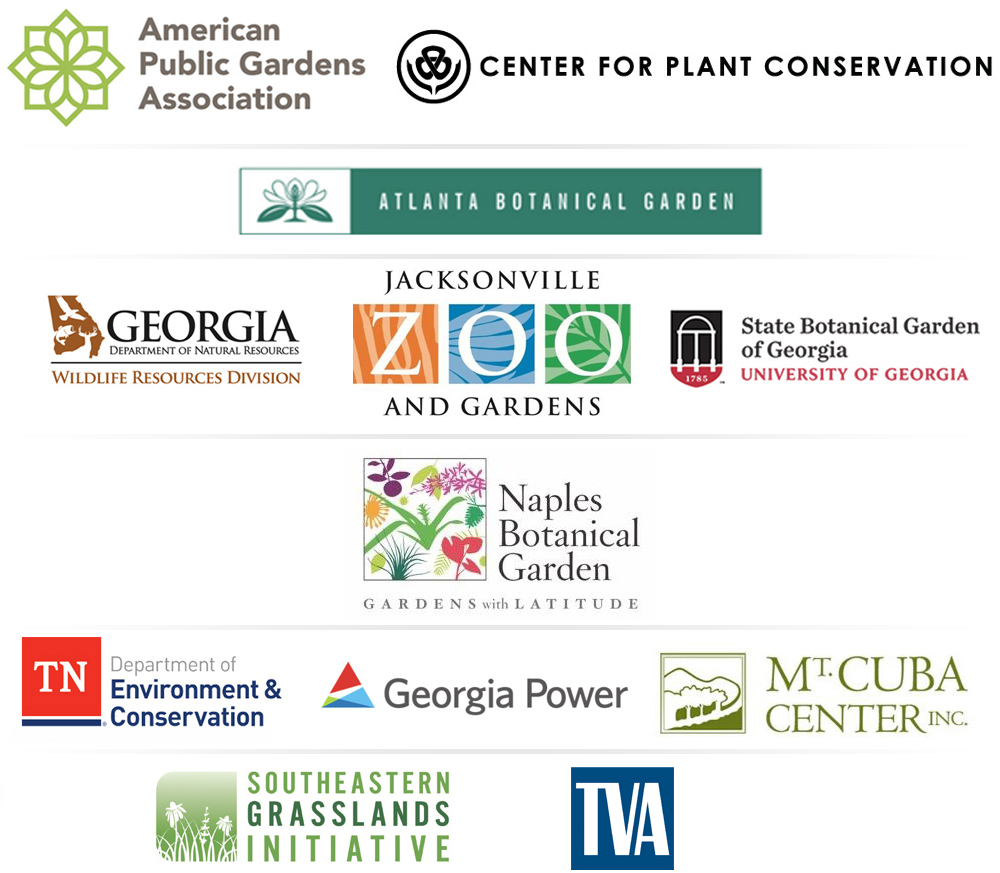2020 Conference Summary
2020 Conference Resources

SePPCon 2020 was held at the Atlanta Botanical Garden from March 2-6, 2020. Pre-conference workshops were held in the Garden’s new Southeastern Center for Conservation, home to the Conservation Genetics and Micropropagation Laboratories. The workshops included training in IUCN Red Listing & NatureServe Ranking, Conservation Horticulture, and Seedbanking & Micropropagation.
Two keynote speakers set the tone for the main conference: Dr. Pamela S. Soltis, Founding Director of University of Florida Biodiversity Institute with Anthropocene Era & the 6th Extinction: Our Reality and Matt Candeias, In Defense of Plants with “Changing the Conversation About Plants”. The entwined themes of modern technology and effective communication continued with inspiring and informative promotional videos during the Regional Conservation Initiatives panel and screening. Other topics included culturally significant plants, state-based conservation alliances, science-based solutions to rare plant recovery, policy & advocacy, management, and private lands conservation. Multiple networking opportunities were incorporated, including a poster session.
Throughout the week, breakout sessions designed to share and build skills for collaboration, communication, fundraising, and volunteers were led by planning team members from across the United States. Small-group skills assessment workshops formed the basis for larger group sessions led by a professional facilitator that sought to identify regional needs and how they can be met by a formal regional alliance. We were prompted to consider our biggest challenges and what success could look like for such a collaborative network, including solutions to our shared challenges.
A post conference workshop on resource prioritization led by Gwen Iacona from Resources for the Future provided examples of how to maximize available resources to leverage the most success. Effectively identifying resource prioritization could further efforts to acquire more funding for plant conservation. Plants receive the both the least amount, and least proportional amount of Endangered Species Act funding, despite being the United States’ largest taxonomic group. Interactive groups assessed the pros and cons of pertinent subjects related to prioritization, including updating data, individual organizations’ priorities, prioritizing actions and threats at the state and regional levels.
SePPCon 2020 was attended by more than 200 people from across the U.S. Participants represented a diverse cross-section of conservationists, including botanical gardens, government agencies, non-profit organizations, private companies, private land-owners, and universities.
SePPCon 2020 Presentation Recordings can be accessed by the general public by joining the CPC Rare Plant Academy & by CPC members through the PI Portal.
SePPCon 2020 Attendee Takeaways
From Ya-Wei Li, Director for Biodiversity at Environmental Policy Innovation Center (EPIC), March 16, 2020 • See Ya-Wei Li’s full article
“…Despite making up the majority of federally endangered species, plants get less than 5 percent of federal and state funding for recovery. On numbers alone, the ESA will never reach its full potential without much more funding and restoration for endangered plants. This is one reason I attended the second Southeastern Partners in Plant Conservation Conference…Below are four of my observations from the conference, focused on how better policies could help save more endangered plants.
(1) By spending money smarter, we can conserve more plants and secure more money for all endangered species.
The problem is that we currently don’t spend money in ways that maximize the diversity of species we conserve. For example, about 5 percent of ESA species get 80 percent of government funding. And the 778 ESA plants get just 3.3 percent of total funding. By reallocating funding more equitably across all ESA species, we can conserve far more biodiversity.
(2) Do endangered plants need stronger legal protections?
…Could and should Congress amend the ESA to extend the take prohibition to plants? Doing so would result in greater protections for plants on non-federal lands. But it might also discourage private landowners from cooperating in plant conservation for fear of those protections resulting in future land use restrictions.
(3) Recovering endangered plants requires a lot of active management, most of which isn’t funded or carried out by the U.S. Fish and Wildlife Service.
…There was a lot of discussion about techniques for conserving endangered plants, especially prescribed burns, invasive species control, and captive propagation and reintroduction. Most of these actions are carried out by botanical gardens, universities, NGOs, state agencies, industry, land trusts, U.S. Forest Service, and private landowners. Rarely did I hear about the U.S. Fish and Wildlife Service having the capacity to pursue these on-the-ground projects.
(4) Endangered plants need a dedicated advocacy campaign.
The gaps in endangered plant conservation are clear, but no national campaign exists to advocate for filling those gaps. How might the botany community try to build that campaign?”
From Dr. Toby Gray, Assistant Research Professor at the Geosystems Research Institute, Mississippi State University, March 12, 2020
“Listening to several hours of talks over the three days, I became more aware of the extensive network of plant conservation opportunities unfolding and taking shape among us all. The challenges to regional and state level plant conservation are daunting, but, as Matt Candeias, the In Defense of Plants podcaster and keynote speaker, said, there is a lot of nature left to save.
I am a geographer in my official capacity as an assistant research professor at Mississippi State University, so I am always interested in the problem of thinking in multiple scales. When you change scales, priorities change. SePPCon is a special kind of meeting because so many of the presentations focus on a single species and associated habitat. But there are also regional scale topics, as well as talks that focus on a particular conservation action, such as fire management in wetlands.
…I really enjoy the mental expansion and contraction, the twists of the kaleidoscope, necessary to begin to understand plant conservation in all its dimensions. For me, SePPCon is a magical week.
As far as how SePPCon 2020 informs the near future of the Mississippi PCA, I will try to summarize my thoughts as best I can. The meeting illuminated for me great potential for action on rights of way (those managed by state DOTs and by utility companies) and private lands (those owned by utility/energy companies and those owned by private individuals). Many participants described efforts to strengthen partnerships in these areas. They don’t happen overnight; they take time and self-conscious, deliberate effort to develop.”
From Vivian Negrón-Ortiz, USFWS Botanist, Panama City Field Office, FL, April 10, 2020
“It is unquestionable- the importance of plants for our environment and society! But, this taxonomic group is in decline, and current conservation toward halting the continuous loss of plant diversity is insufficient at the global, national and local scales. As the rare become ‘rarer’, the plant conservation situation remains an ode of the past, “Importance disregarded, Underfunded, Not fully protected by policies.” While this depiction is quite daunting, sometimes we come across, we are part of, an assembly of individuals challenging the ode.
The Southeastern Partners in Plant Conservation (SePPCon) 2020 did that! During this conference, the conservation community communicated achievements, science, and approaches, and engaged in productive discussion. From regional initiatives to medicinal plants, recovery, genetics, safeguarding, private land and rights-of way conservation, forecasting, and break-out sessions, among others, what emerged revealed the progress we have and continue to make in the Southeast. SePPCon 2020 illustrates what other regions can emulate.”
2020 Sponsors

2020 SePPCon Partners:
| • American Public Gardens Association • Atlanta Botanical Garden • Botanic Gardens Conservation International U.S. • Center for Plant Conservation • Donald E. Davis Arboretum at Auburn University • Georgia Department of Natural Resources Wildlife Conservation • Mt. Cuba Center • Jacksonville Zoo & Gardens • Naples Botanical Garden • National Wildlife Refuge Association |
• NatureServe • North Carolina Botanical Garden • North Carolina Department of Natural & Cultural Resources • Office of Kentucky Nature Preserves • State Botanical Garden of Georgia at the University of Georgia • Tennessee Department of Environment & Conservation • USDA Forest Service • U.S. Fish & Wildlife Service |
